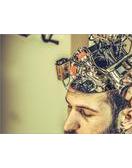Not A Head Cold?
 Tasmania, Australia
Tasmania, Australia My name is Julianne. I am 64 years old and live in Devonport, a city in northern Tasmania. Tasmania is a large island state located 240 km (150 mi) south of the Australian mainland. I was diagnosed with Superficial Siderosis in September 2011, so nearly ten years! In April 2011, I went to my doctor after losing my sense of smell and having trouble with my hearing I thought was part of a heavy head cold. I was also struggling a bit as my legs felt like lead at the same stage when I tried to run, but I had no idea that the two were related!
 Julianne sharing
Julianne sharingSS awareness bracelets
The Specialists
My GP referred me to an ENT specialist, who sent me for an MRI scan. My MRI showed what looked like a pituitary adenoma (Pituitary adenomas are benign tumours of the pituitary gland), so I was sent first to an endocrinologist and then to a neurosurgeon. The report also mentioned a past sub-arachnoid bleed. Although concerned about the black spots on my brain, we decided to tackle one thing at a time, so I had surgery to remove the tumour on my pituitary gland in September. Turned out to be no tumour. I had Pituitary Hyperplasia. My pituitary gland was the size of a tumour (walnut). I had the part of the pituitary gland removed that was pressing on my right optical nerve and had a biopsy done, which returned a benign result.
Dr. Google Makes The Diagnosis
Before the surgery, my neurosurgeon diagnosed the black spots as SS - as had I. (I reckon like me, he had asked Dr Google as he had never seen it before.) After the pituitary gland surgery, he sent me to a neurologist who organised for me to have a CT myelogram which identified a pseudomeningocele between C1/T4. Because of its size, I was sent for a more in-depth CT myelogram a few months later to determine the actual bleed site so the surgeon knew where to operate. It was found at the T3/T4 level.
Locating The Trouble
The German professor who performed the second CT myelogram told me the dura is like a seam in a jumper. If you pull too hard in one spot, you will get a hole up further. I had spinal surgery in May 1992 - 19 years before diagnosis- at T11/12, and the pseudomeningocele was at T3/4. It was a textbook case!

I already had neurological issues from a disc crushing my spinal cord - hence my first 1992 surgery - resulting in me having Brown Sequard syndrome, which magnified my SS. I had an MRI scan in 2007 after having chronic sciatica. Unfortunately, the SS was not picked up at this scan; otherwise, I wouldn't have any real issues now.
Fixing The Source
In July 2012, I had a hemilaminectomy to remove the pseudomeningocele, which had set up its own blood supply (and contained a large disintegrating old blood clot). They hoped it was the source of the bleed. I had 10 days in hospital, six of which were spent flat on my back. A drain from my spine was taking out 5ml of fluid every hour to give the graft from my leg (which was glued and stitched), used to seal off the dura, giving it a better chance of healing. My spinal fluid started off the colour of stale urine (with red stripes) and, after six days, was the colour of pale straw.
The Situation Worsens
I recovered well and was almost back to where I had been. On 21st December 2012, I was struck by closing automatic doors in a store while shopping. I fell back onto the pavement, knocked unconscious, fracturing my skull - the occipital bone on the right side.
I have never been the same since.In 2018, as part of my legal claim, I saw a neuropsychiatrist who diagnosed me with Functional Neurological Disorder, which is like post-traumatic stress of the brain. Unfortunately, this exacerbates all my neurological symptoms. I lost more hearing on the right side, my balance and gait are much worse, and I have chronic tiredness. After eight and a half years of money, frustration, and tears, we have finally settled with the store. Still, unfortunately, no amount of money will ever make me better.
Controlling My symptoms
Since the accident in 2012, I have done everything I can - from changing my diet, regular massage and chiropractor appointments, supplements, physio, PT, Pilates, and walking indoors with my hand weights. I recently found out about and started vestibular rehabilitation. It is a long, hard road, but I am determined to be the best version of myself that I can be.
I hadn't tried chelation therapy as my neurologist wouldn't hear of it when I was first diagnosed, as Deferiprone was still in its trial phase. He thought I didn't need it as I had my bleed ablated, believing there should be no more progression. I haven't seen my neurologist since September 2016. He felt he didn't need to see me unless I had any worsening of my symptoms. I am seeing him again in September, so I will raise the issue of the Deferiprone again.
Going Forward
Luckily, my hearing hasn't changed since my fall. My other symptoms seem stable, although I have developed insomnia and double vision in my right eye in the last couple of years. Apart from these, I have a loss of hearing in both ears (I need hearing aids), gait ataxia, balance issues and chronic tiredness. I am fortunate that I don't have any pain, and I lead a reasonably normal life. I have a wonderful husband, family and friends who support me as well. Like all of us, I am a work in progress
**Just a footnote: I think follow up MRI scans should be mandatory after spinal surgery, which would avoid a lot of heartaches.
